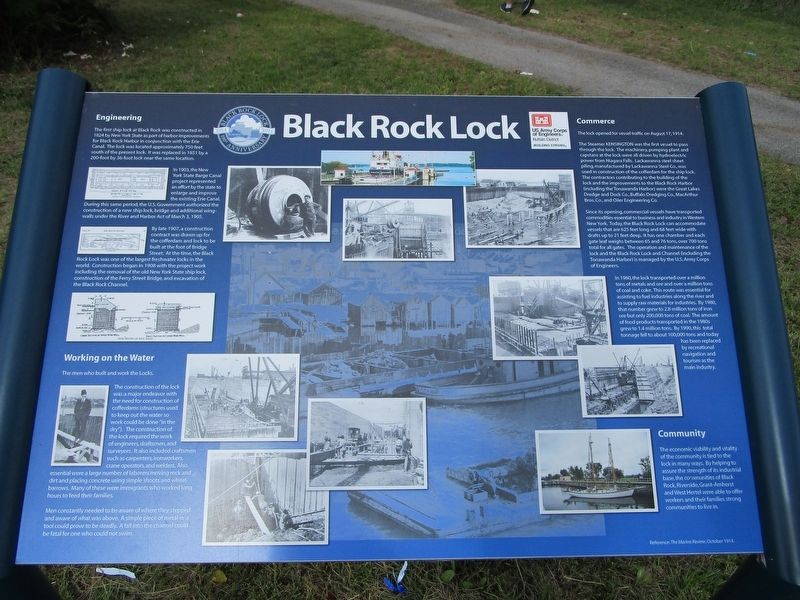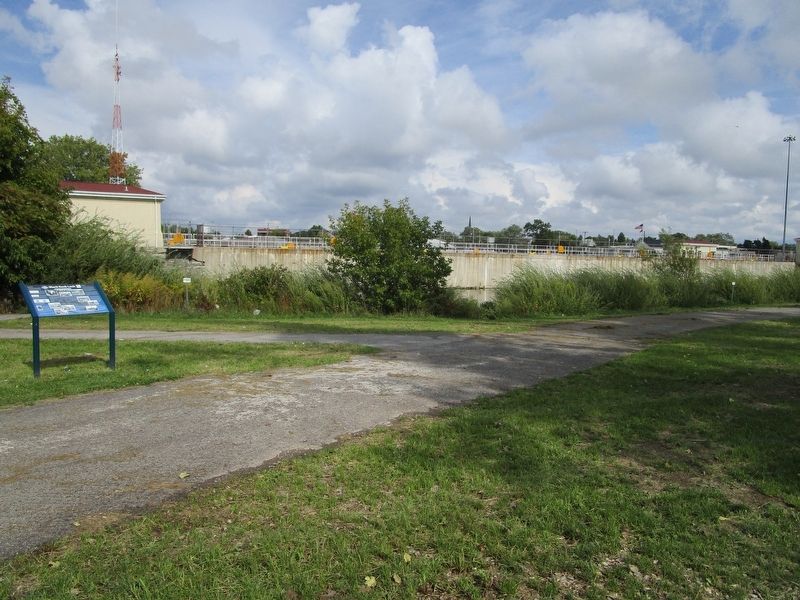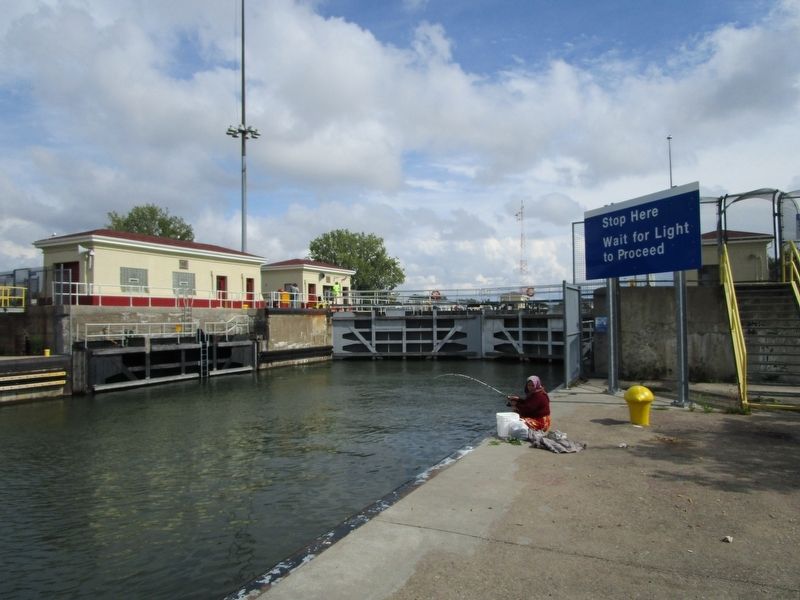Black Rock in Buffalo in Erie County, New York — The American Northeast (Mid-Atlantic)
Black Rock Lock
100th Anniversary 1914 - 2014
Engineering
The first lock at Black Rock was constructed in 1824 by New York State as part of harbor improvements for Black Rock Harbor in conjunction with the Erie Canal. The lock was located approximately 750 feet south of the present lock. It was replaced in 1851 by a 200-foot by 36-foot lock near the same location.
In 1903, the New York State Barge Canal project represented an effort by the state to enlarge and improve the existing Erie Canal. During this same period, the U.S. Government authorized the construction of a new ship lock, bridge, and additional wing-walls under the River and Harbor Act of March 3, 1905.
By late 1907, a construction contract was drawn up for the cofferdam and lock to be built at the foot of Bridge Street. At the time, the Black Rock Lock was one of the largest freshwater locks in the world. Construction began in 1908 with the project work including the removal of the old New York State ship lock, contruction of the Ferry Street Bridge, and excavation of the Black Rock Channel.
Working on the Water
The men who built and work the locks.
the construction of the lock was a major endeavor with the need for contruction of cofferdams (structures used to keep out the water so work could be done "in the dry"). The construction of the lock required the work of engineers, draftsmen, and surveyors. It also oncluded craftsmen such as carpenters, ironworkers, crane operators, and welders. Also essential were a large number of laborers moving rock and dirt and placing concrete using simple shoots and wheelbarrows. Many of these were immigrants who worked long hours to feed their families.
Men constantly needed to be aware of where they stepped and aware of what was above. A simple piece of metal or a tool could prove to be deadly. A fall into the channel could be fatal for one who could not swim.
Commerce
The lock opened for vessel traffic on August 17, 1914.
The steamer KENSINGTON was the first vessel to pass through the lock. The machinery, pumping plant and capstans at the lock were all driven by hydroelectric power from Niagara Falls. Lackawanna steel sheet piling, manufactured by Lackawanna Steel Co., was used in construction of the cofferdam for the ship lock. The contractors contributing to the building of the lock and the improvements to the Black Rock Harbor (including the Tonawanda Harbor) were the Great Lakes Dredge and Dock Co., Buffalo Dredging Co., MacArthur Bros., Co., and Oiler Engineering Co.
Since its opening, commercial vessels have transported commodities essential to business and industry in Western New York. Today, the Black Rock Lock can accommodate vessels that are 625 feet long and 68 feet wide
with drafts up to 21 feet deep. It has one chamber and each gate weighs between 65 and 70 tons, over 700 tons total for all gates. Th eoperation and maintenance of the lock and the Black Rock Lock and Channel (including the Tonawanda Harbor) is managed by the U.S. Army Corps of Engineers.
In 1960, the lock transported over a million tons of metals and ore and over a million tons of coal and coke. This route was essential for assisting to fuel industries along th eriver and to supply raw materials for industries. By 1980, that number grew to 2.8 million tons of iron ore, but only 200,000 tons of coal. The amount of food products transported in the 1980s grew to 1.4 million tons. By 1990, this total tonnage fell to about 100,000 tons and today has been replaced by recreational navigation and tourism as the main industry.
Community
The economic viability and vitality of th ecommunity is tied to the lock in many ways. By helping to assure the strength of its industrial base, the communities of Black Rock, Riverside, Grant-Amherst and West Hertel were able to offer workers and their families strong communities to live in.
Rference: The Marine Review, October 2014.
Erected 2014 by US Army Corps of Engineers, Buffalo District.
Topics. This historical marker is listed in this topic list: Waterways & Vessels
. A significant historical date for this entry is March 3, 1905.
Location. 42° 56.05′ N, 78° 54.403′ W. Marker is in Buffalo, New York, in Erie County. It is in Black Rock. Marker can be reached from Niagara Street (New York State Route 266). Marker is on Unity Island (nee Squaw Island) in Broderick Park. It is at the north end of the park road in the northern part of the island. From Niagara Street at the International Railway Bridge, access Unity Island via the single vehicle lane on the section of the bridge over the Black Rock Channel. Touch for map. Marker is in this post office area: Buffalo NY 14213, United States of America. Touch for directions.
Other nearby markers. At least 8 other markers are within walking distance of this marker. Buffalo and Niagara Falls Railroad (approx. ¼ mile away); Burning of Blackrock and Buffalo (approx. ¼ mile away); Jubilee Springs (approx. ¼ mile away); Market Square (approx. ¼ mile away); Black Rock (approx. ¼ mile away); Black Rock Harbor (approx. ¼ mile away); a different marker also named Market Square (approx. ¼ mile away); Stephen W. Howell (approx. 0.3 miles away). Touch for a list and map of all markers in Buffalo.
Credits. This page was last revised on February 16, 2023. It was originally submitted on September 18, 2016, by Anton Schwarzmueller of Wilson, New York. This page has been viewed 522 times since then and 36 times this year. Photos: 1, 2, 3. submitted on September 18, 2016, by Anton Schwarzmueller of Wilson, New York.


